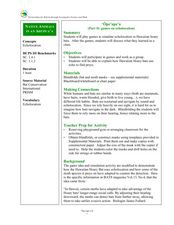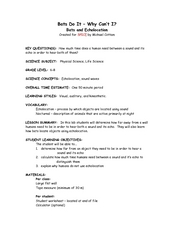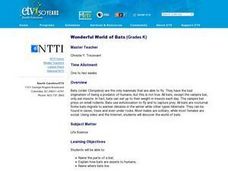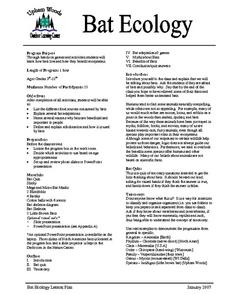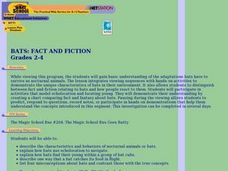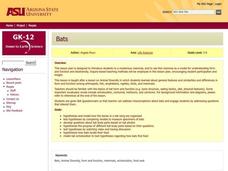Discovery Education
Sonar & Echolocation
A well-designed, comprehensive, and attractive slide show supports direct instruction on how sonar and echolocation work. Contained within the slides are links to interactive websites and instructions for using apps on a mobile device to...
Curated OER
Games on Echolocation
Get a little batty with life science! This fun simulation game replicates how bats use echolocation to hunt moths in their native Hawaiian habitat. After creating blind folds and discussing some basic principles of echolocation, students...
Curated OER
Echolocation
Learners explore echolocation. In this bats science lesson, students compare sunlight reflecting off a mirror to sound waves hitting a bat's ears. Learners complete a worksheet about bats.
Curated OER
How Do Bats Navigate At Night?
Through an experiment, learners explore how bats use echolocation. First, they discuss how sound travels through air waves. Then, they talk about the ways bats navigate in the dark. As an extension, they can write about what they have...
Curated OER
Blind as a Bat?
Imagine using your ears and voice to see. That is what bats do with echolocation. Demonstrate how echolocation works with this fun game for your classroom. Buzz, buzz!
Curated OER
Bats Do It-Why Can't I?
Students explore echos and how they are utilised in navigation. For this sound lesson students calculate the amount of time between a sound and its echo.
Curated OER
Wonderful World of Bats
Students create a book about bats. They write a letter to a scientist containing questions about bats. They compare the socialization of bats to humans; compare the needs of bats to humans and other animals.
Curated OER
Bat Ecology
Students, through hands on games and activities, discover how bats live and how bats benefit ecosystems. They play a game designed to show them how echolocation works and another to show how mother bats locate their young through their...
Curated OER
Bat Quest: In Search of Stellaluna
Students participate in Bat Quest: In Search of Stellaluna. In this children's literature activity students listen to the reading of Stellaluna. Computers are utilized to enter the Bat Quest site to research various topics on bats....
Curated OER
Bats
Students investigate bats. In this animal science lesson, students use several websites and suggested bat books to write an informative paragraph. Students should be able to write with 90% accuracy.
K12 Reader
They See with Their Ears
Sometimes bats get a bad rap, even though they are fascinating creatures! Teach your class about echolocation with a reading passage. After reading, class members respond to five questions based on the text.
Curated OER
Bat Program
Young scholars, through hands on games and activities, discover how bats live and how bats benefit ecosystems. They play a game designed to show them how echolocation works. They take a quiz to dispel some of the myths associated with bats.
Curated OER
Bats are Our Buddies!
In this bats worksheet, students click on the links in the questions about bats to find the answers to the questions and then come back and answer the questions. Students answer 19 questions total.
Curated OER
Bats: Fact and Fiction
Students describe the characteristics and behaviors of bats. After viewing a video, they explain how bats use echolocation to navigate and how they find their young within a group. They list four misconceptions about the animal and...
Curated OER
Bats
Young scholars hypothesize and model how the bones in a bat wing are made up. In this exploratory lesson students test their hypothesis, develop questions about bat parts and watch a video on bats.
Curated OER
Brillant, Beautiful Bats!
Students use the internet to gather information on bats. They write their own bat poem and describe the differences between the parts of a bat's body. They identify how bats are important to humans and how they control the insect...
Curated OER
Bats, Bats, Everywhere!
Students research information on bats while working in cooperative groups. They design posters with the information from their research.
Curated OER
Greater Horseshoe Bat
In this Greater Horseshoe Bat worksheet, students read the passage on another page and then answer seven comprehension questions.
Curated OER
Bat Word Unscramble
In this bat word unscramble activity, students determine 10 words that are associated with bats. They write two facts about bats using a number of the words that they unscrambled.
Curated OER
Bats Migrate South
Students examine the life of bats in Illinois. Using the internet, they research the history of the bat in Illinois and describe the way they find prey by using echolocation. They report their findings to the class and answer any...
Curated OER
We're Batty
Students watch a video about bats and compare and contrast them to birds. They identify the specific characteristics that identify bats as mammals and what makes them unique from other mammals.
Curated OER
Hunting For Bats
Fourth graders investigate the adaptations that occur in bats. The benefits of adaptations are discussed with them and the probability of survival is measured. The specific adaptations are written and defined.
Curated OER
Bats
Learners model how the bones in a bat wing are organized. They develop questions about bat body parts based on photographs. They hypothesize how bats locate their food.
Curated OER
guided reading lesson using BATS
Students answer questions, then after reading several bat books, students revisit the questions.



